A SUGGESTED TIME AND TROUBLE-SAVING ITINERARY FOR THE MANY POINTS OF INTEREST AT THE R.A.S.E. SHOW AT DONCASTER.
Page 16

Page 17

Page 18
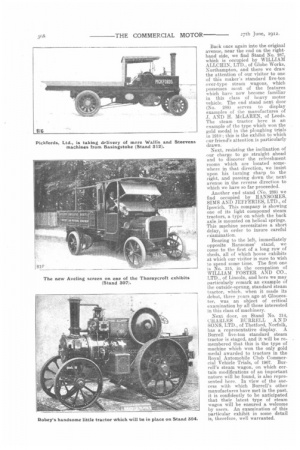
Page 19
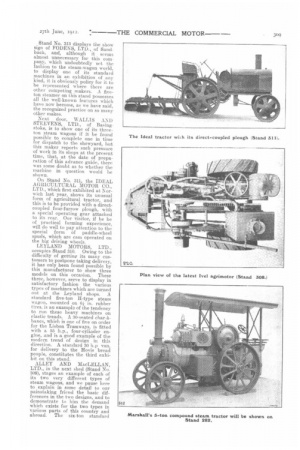
Page 20
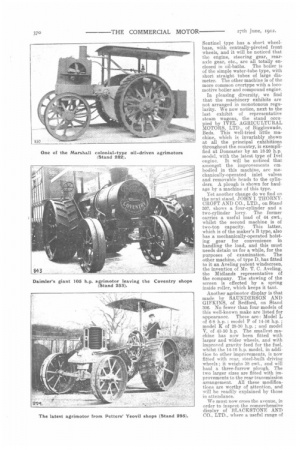
Page 21
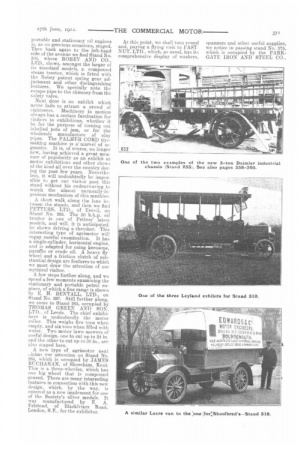
Page 22

Page 23
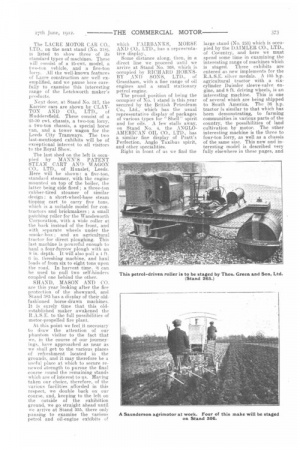
Page 24
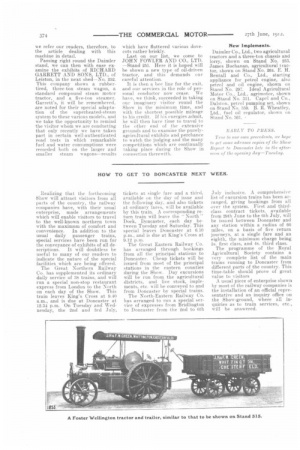
If you've noticed an error in this article please click here to report it so we can fix it.
Arrived at the Show-ground, in all probability by tramcar, our mythical visitor enters by the main race-course buildings. This year, the R.A.S.E. authorities have not been under the necessity of erecting their well-known range of administrative buildings, which always form a picturesque entrance to the Show-ground.
From the rising ground at the side of the magnificent pear-shaped race-course, which, by the way, has recently undergone structural alterations involving an expenditure of many thousands of pounds, a magnificent prospect of the whole showyard is available. The favoured few, and, of course, our personallyconducted visitor is one of them, may climb to the top of one or other of the permanent race-course buildings and secure a bird's-eye view of the whole of the Doncaster Showground which w ill well repay him for this temporary digression. The route then leads across the racecourse itself over a special plank gangway, and, fortunately for our traveller, the implement yard is the first part of the ground at which he arrives. As a matter of fact, two of the big exhibitors in whom we are all interested occupy the first stands in the ground. We will, however, rigidly insist upon our visitor's pursuing the suggested itinerary, and will not allow him to be side-tracked, in order to inspect something which catches his eye to the right or to the left ; he will see everything all in good time, and thus save much weariness and insure "foot-ease," as Selfridge's put it, as far as possible.
First of all, a halt is called at Stand 204, where AVELING AND PORTER, LTD., amongst some of its bigger exhibits, shows one of its compound steam tractors, and we must note that this is fitted with a small Belpaire boiler, with a winding drum and rope, and all the usual etceteras of these handy little "steam horses." A machine, which, if it arrives, it will pay to inspect with some considerable care, is the new Aveling three-ton petrol lorry, upon which, we are given to understand at the time of writing, many interesting features will be found. Some time, therefore, should be spent in examining this new machine, which is quite a departure for the celebrated Rochester maker. A five-ton petrol roller was another new model to be shown here, blit early advices inform us that it was not possible to complete this in time for shipment to Doncaster.
Passing down the further side of this stand, and taking the opportunity at the same time to examine the exhibits in the adjacent shed (Stand No. 205), we shall notice that CLAYTON AND SHUTTLEWORTH, LTD., amongst a number of general exhibits, also has listed one of its latest designs of standard tractors, and it has been promised that its new design of steam wagon shall also see the light here for the first time. If it be staged, our visitor will do well to study this model with more than usual care. It is designed with a Belpaire firebox,. and there is a special cylinderseating arrangement. The feedpump is driven from the countershaft, and so is of low speed.
Arrived at the end of Stand 205, we turn sharp to the left and go straight along the broad avenue between the sheds which then confronts us. Stand No. 211 houses the exhibits of JOSEPH OWEN AND SONS, LTD., of Liverpool, where the usual fine display of timber and manufactured carriage and wagon components will be found. This exhibit will naturally demand some of the time of our visitor, if he be particularly interested in the coachbuilder's side of the industry.
The next stand in this avenue which need attract our attention is No. 278, which is some distance along on the right-hand side. This is occupied by R. A. LISTER AND CO., LTD., which also shows on Stands 221 and 439, but it is on 278 where we find a fine and comprehensive display of small stationary petrol engines. The self-contained electric-lighting plant is also worthy of attention.
A little further along on the same side is Stand No. 280, where the well-known Peterborough motor rollers are shown by BARFORD AN]) PERKINS, LTD. No fewer than five of these interesting little specialities are listed by this maker, and they one and all merit attention. Some time should therefore be spent here in examination of the individual machines. The largest to be shown is an 8f-tonner, which is used for road-making purposes, and another interesting example is one which is particularly designed for agricultural work. This weighs only 1 ton, and is 6 ft. in width. Of this last type, it is interesting to note that an example, which has recently been purchased by the Corporation of Doncaster, has been used extensively in connection with the preparation of the Royal Show ground. It should also be noted that this little machine can be fitted with what are known to farmers as Cambridge-pattern roller rings. Barford and Perkins, Ltd., informs us that it is actually manufacturing, at the present time, standard motor rollers of its design in twenty different sizes, and that these vary in weight from 1i ton to 14 tons.
A stand on the left next calls for a halt in our peregrinations. This houses the display of W. H. WILLCOX AND CO., LTD. It is useless to attempt to give any advance idea of the multitudinous display which is invariably made by this well-known engineer's store keeper, but it is safe to assume that the ini,st captious oi critics will nod enough to interest him on Stand 231 to justify a delay of more than a few minutes. Injectors, wirebound hose, semi-rotary pumps, water-lifters and lubricators of all kinds are but a tithe of the many components and supplies which are here to be seen.
Once again to the right, but a little further ahead, is Stand No. 282, occupied by MARSHALL, SONS AND CO. LTD. A great display of agricultiiral machinery is here staged, but in particular our visitor must. examine a five-ton compound steam tractor as well as the two examples of oil tractor with which this company is so rapidly building up a reputation in all parts of the world. One is of the 52 h.p. type, the smaller one having an engine of 16 h.p. As evidence of the hold which this maker has secured on this interesting branch of the industry, we may record that Marshall oil tractors are being used with every success for ploughing, transport, and driving fixed machinery in Canada, the Argentine Republic, Brazil, Peril, Uruguay, Patagonia, Australia, New Zealand, Tasmania, India, Straits Settlements, Union of South Africa, Portuguese East Africa, Nyassaland, Persia, Palestine, Turkey in Asia, Russia, and Germany. A slight detour from the main route takes us to Stand No. 240, immediately backing 241, to which we go first. On Stand 240, the STUDEBAKER CORPORATION OF ENGLAND, LTD., shows several American motor vehicles, and, incidentally, a Flanders delivery van, which is priced at £200.
Back once again into the original avenue, near the end on the right
hand side, we find Stand No. 287,
which is occupied by WILLIAM ALLCHIN, LTD., of Globe Works, Northampton, and there we draw the attention of our visitor to one of this maker's standard five-ton over-type steam wagons, which possesses most of the features which have now become familiar in this class of heavy motor vehicle. The end stand next door (No. 288) serves to display examples of the manufactures of J. AND H. MeLAREN, of Leeds. The steam tractor here is an example of the type which won the gold medal in the ploughing trials in 1910 ; this is the exhibit to which our friend's attention is particularly drawn.
Next, resisting the inclination of our charge to go straight ahead and to discover the refreshment rooms which are located somewhere in that direction, we insist upon his turning sharp to the right, and passing down the next avenue in the reverse direction to which we have so far proceeded.
Another end stand (No. 289) we find occupied by RANSOMES, SIMS AND JEFFERIES, LTD., of Ipswich. This company is showing one of its light compound steam tractors, a type on which the back axle is mounted on helical springs. This machine necessitates a short delay, in order to insure careful eiammation.
Bearing to the left, immediately opposite Ransomes' stand, we come to the first of a long row of sheds, all of which house exhibits at which our visitor is sure to wish to spend some time. The first one is No. 315, in the occupation of WILLIAM FOSTER AND CO., LTD., of Lincoln, and here we may particularly remark an example of the outside-sprung, standard steam tractor, which, when it made its debut, three years ago at Gloucester, was an object of critical examination by all those interested in this class of machinery.
Next door, on Stand No. 314, CHARLES BURRELL A N D SONS, LTD., of Thetford, Norfolk, has a representative display. A Burrell five-ton standard steam tractor is staged, and it will be remembered that this is the type of machine which won the only gold medal awarded to tractors in the Royal Automobile Club Commercial Vehicle Trials, of 1907. Burrell's steam wagon, on which certain modifications of an important nature will be found, is also represented here. In view of the success with which Burrell's other manufactures have met in the past, it is confidently to be anticipated that their latest type of steam wagon will be ensured a welcome by users. An examination of this Particular exhibit in some detail is, therefore, well warranted. Stand No. 313 displays the show sign of FODENS, LTD., of Sandbach, and, although it seems almost unnecessary for this company, which undoubtedly set the fashion to the steam-wagon world, to display one of its standard machines in an exhibition of any kind, it is obviously policy for it to be represented where there are other competing makers. A fiveton steamer on this stand Possesses all the well-known features which have now become, as we have said, the recognized practice on so many other makes.
Next door, WALLIS AND STEEVENS, LTD., of Basingstoke, is to show one of its threeton steam wagons if it be found possible to complete one in time for dispatch to the showyard, but this maker reports such pressure of work in its shops at the present time, that, at the date of preparation of this advance guide, there was some doubt as to whether the machine in question would be shown.
On Stand No. 311, the IDEAL AGRICULTURAL MOTOR CO., LTD., which first exhibited at Norwich last year, shows its unusual form of agricultural tractor, and this is to be provided with a directcoupled four-furrow plough, with a special operating gear attached to its rear. Our visitor, if he be of practical farming experience, will do well to pay attention to the special form of paddle-wheel spuds, which are cam operated on the big driving wheels.
LEYLAND MOTORS, LTD., occupies Stand 310. Owing to the difficulty of getting its many customers to postpone taking delivery, it has only been found possible by this manufacturer to show three models on this occasion. These three, however, serve to display in satisfactory fashion the various types of machines which are turned out at the Leyland shops. A standard five-ton H-type steam wagon, mounted on 6 in. rubber tires, is an example of the tendency to run these heavy machines on elastic treads. A 30-seated char-A-banes, which is one of five on order for the Lisbon Tramways, is fitted with a 55 h.p., four-cylioder engine, and is a. good example of the modern trend of design in this direction. A standard 30 h.p van, for delivery to the Hovis bread people, constitutes the third exhibit on this stand.
. ALLEY AND MAcLELLAN, LTD., in the next shed (Stand No. 309), stages an example of each of its two very different types of steam wagons, and we pause here to explain in some detail to our painstaking friend the basic differences in the two designs, and to demonstrate to him the demand which exists for the two types in various parts of this country and abroad. The six-ton standard Sentinel type has a short wheelbase, with centrally-pivoted front wheels, and it will be noticed that the engine, steering gear, rearaxle gear, etc., are all totally enclosed in oil-baths. The boiler is of the simple water-tube type, with short straight tubes of large diameter. The other machine is of the more common overtype with a locomotive boiler and compound engine.
In pleasing diversity, we find that the machinery exhibits are not arranged in monotonous regularity. We now notice, next to the last exhibit of representative steam wagons, the stand occupied by IVEL AGRICULTURAL MOTORS, LTD., of Biggleswade, Beds. This well-tried little machine, which is invariably shown at all the principal exhibitions throughout the country, is exemplified at Doncaster by an 18-20 h.p. model, with the latest type of Ivel engine. It will be noticed that amongst the improvements embodied in this machine, are mechanically-operated inlet valves and removable heads to the cylinders. A plough is shown for haulage by a machine of this type.
Yet another change do we find on the next stand_ JOHN I. THORNYCROFT AND CO., LTD., on Stand 307, shows a four-cylinder and a two-cylinder lorry. The former carries a useful load of 44 cwt.. whilst the second machine is of two-ton capacity. This latter, which is of the maker's B type, also has a mechanically-operated hoisting gear for convenience in handling the load, and this must needs detain us for a while, for the purposes of examination. The other machine, of type D, has fitted to it an Aveling patent windscreen, the invention of Mr. T. C. Aveling, the Midlands representative of the company. The stowing of the screen is effected by a spring inside roller, which keeps it taut.
Another agrimotor display is that made by SAUNDERSON AND GIFRINS, of Bedford, on Stand 306. No fewer than four models of this well-known make are listed for appearance. These are : Model L of 6-8 h.p. ; model F of 14-16 h.p. ; model K of 28-30 h.p. ; and model V, of 45-50 h.p. The smallest machine has now been, fitted with larger and wider wheels, and with improved gravity feed for the fuel, whilst the 14-16 h.p. model, in addition to other improvements, is now fitted with rear, steel-built drivine wheels ; it weighs 38 cwt., and will haul a three-furrow plough. The two larger sizes are fitted with improvements to the rear transmission arrangement. All these modifications are worthy of attention, and will be readily explained by those in attendance.
We must now cross the avenue, in order to inspect the comprehensive display of BLACKSTONE AND CO., LTD., where a useful range of
portable and stationary oil engines is, as on previous occasions, staged. Then back again to the left-hand side of the avenue we find Stand No. 304, where ROBEY AND CO., LTD., shows, amongst the larger of its standard models, a compound steam tractor, which is fitted with the Robey patent spring gear adjustment and other distinguishing features. We specially note the escape pipe to the chimney from the safety valve.
Next door is an exhibit which never fails to attract a crowd of sightseers. Machinery in motion always has a certain fascination for visitors to exhibitions, whether it be for the purpose of turning out labelled pots of jam, or for the wholesale manufacture of clay pipes. The PALMER CORD tiremaking machine is a' marvel of ingenuity. It is, of course, no longer new, having achieved a great measure of popularity as an exhibit at motor exhibitions and other shows of the kind all over the country during the past few years. Nevertheless, it will undoubtedly be impos• sible to get our visitor past this stand without his endeavouring to watch the almost uncannily-in genious mechanism of this machine.
A short walk along the lane between the stands, and then we find PETTERS, LTD., of Yeovil, on Stand No. 295. The 30 b.h.p. oil tractor is one of Petters' latest models, and will, it is anticipated. be shown driving a thresher. This interesting type of agrimotor will repay careful examination. It has a single-cylinder, horizontal engine, and is adapted for using kerosene, paraffin or crude oil. A heavy fly. wheel and a friction clutch of substantial design are features to which we must draw the attention of our mythical visitor.
A few steps further along, and we spend a few moments examining the stationary and portable petrol engines, of which a fine range is shown by E. H. BENTALL, LTD., on Stand No. 297. Still further along, we come to Stand 265, occupied by THOMAS GREEN AND SON, LTD., of Leeds. The chief exhibit here is undoubtedly the motor roller. This weighs Ave tons when empty, and six tons when filled with water. Two motor lawn mowers of useful design, one to cut up to 24 in, and the other to cut up to 30 in., are also staged here.
A new type of agrimotor next Jaims our attention on Stand No.
261, which is occupied by JAMES BUCHANAN, of Shoreham. Kent. This is a three-wheeler, which has one big wheel that is compound geared. There are many interesting features in connection with this new design, which, by the way, is entered as a new implement for one of the Society's silver medals. It was manufactured by E. A. Felstead, of Bla.ckf riars Road, London, S.F., for the exhibitor. At this point, we shall turn round and, paying a flying visit to EAST NUT, LTD., which, as usual, has its comprehensive display of washers,
spanners and other useful supplies, we notice in passing stand No. an, which is occupied by the PARKGATE IRON AND STEEL CO., LTD., where an instructive display of Siemens' open-hearth steel, suitable for boilers and agricultural implements of all kinds, is staged. The STERN SONNEBORN OIL CO., LTD., shows a quantity of its oils and greases on Stand No. 376. Entering another avenue soon after. we arrive at Stand 341, where PRICE'S PATENT CANDLE CO., LIT., has an attractive display of all its many varieties of lubricants. A small Tangye oil-engine is also shown, and we pause to point out the technical characteristics of an interesting display of oil-testing apparatus. Two stands away, the EAGLE ENGINEERING CO., LTD., Warwick, has a fine display of petrol engines of various sizes. An electric-lighting plant and a pumping plant are also included on this stand.
A short walk again brings Us to a range of sheds which house many exhibits which are of interest to us,. The first on the left (No. 328) is in possession of W. TASKER AND SONS, LTD., of Andover, with one of the favourite "Little Giant" steam tractors, fitted with a hauling drum neatly disposed beneath the boiler barrel, whilst a Tacker steam wagon is another example of this maker's products which it will pay us to examine with care. A standard B2 compound "Little Giant" tractor is also staged. A stout example of trailer, for use with steam wagons and tractors, is another item on this stand which we should pause to examine.
J. AND E. HALL, LTD., of Dartford, on Stand 321, a little further along, is exhibiting three machines. One of these is a three-ton, chaindriven, plank-sided tilt van, of the type which this company supplies to furniture removers and general contractors. The second machine is a four-ton standard chassis, whilst the remaining exhibit is a five-ton tipping wagon built to the order of the Fast Suffolk County Council. All these machines are of the standard Hallford design, and are first-class examples of modern commercial-vehicle manufacture. and may be carefully studied with that knowledge. Next door, the YORKSHIRE COMMERCIAL MOTOR CO., of Leeds, one of the few manufacturing concerns which builds both steam and petrol chassis, has a sixton steam wagon, which. is fitted with a patent mechanically-operated tipping gear. The other exhibit is a 15 cwt., standard commercial-vehicle chassis, of the type with which we recently conducted a successful trial in Yorkshire. Both these machines will repay careful examination, as being representative of their types.
WALKER BROS., LTD., of Wigan, has, on Stand No. 319, two examples of its standard Pagefield petrol vehicles. One is a 28 b.p., four-cylinder, two-ton lorry ; the other is a chassis of similar type. It is interesting to note that Walker Bros., Ltd., intends to have a demonstration vehicle in the vicinity of the Show-ground, in order that interested persons may make trials on the road if they desire it. The LACRE MOTOR CAR CO., LTD., on the next stand (No. 318), is listed to show three of its standard types of machines. These m, ill consist of a 25-cwt. model, a two-ton vehicle, and a five-ton lorry. All the well-known features of Lacre construction are well exemplified, and we pause here carefully to examine this interesting range of the Letchworth maker's products.
Next door, at Stand No. 317, the Karrier ears are shown by CLAYTON AND CO., LTD., of Huddersfield. These consist of a 25-30 cwt. chassis, a two-ton lorry, a two-ton chassis, a special horse van, and a toyer wagon for the Leeds City Tramways. The two last-mentioned exhibits will be of exceptional interest to all visitors to the Royal Show, The last shed on the. left is occupied by MANN'S PATENT STEAM CART AND WAGON Ca, LTD., of Htinslef, Leeds. Here will be shown: a five-ton, standard steamer, with the engine mounted on top of the boiler, the latter being side fired ; a three-ton rubber-tired steamer of similar design ; a short-wheel-base steam tipping cart to carry five tons, which is a suitable model for contractors and brickmakers ; a small patching roller for the Wandsworth Corporation, with a wide roller at the back instead of the front, and with separate wheels under the smoke-box: and an agricultural tractor for direct ploughing. This last machine is powerful enough to basil a four-furrow plough with an 8 in. depth. It will also null a.1 ft.
in. threshing machine, and haul loads of from six to eight tons upon the road. In harvest time, it can be used to null two self-binders coupled one behind the other.
SH..-1..ND, MASON AND CO. are this year looking after the fire protection of the sbowyard, and Stand 385 has a display of their oldfashioned horse-drawn machines. It is surely time that this oldestablished maker awakened the R.A.S.E. to the full possibilities of motor-propelled fire plant.
At this point we feel it necessary to draw the attention of our phantom visitor to the fact that we, in the course of our journeyings, have approached as near as we shall get to the various places of refreshment located in the grounds, and it may therefore be a useful place at which to secure renewed strength to pursue the final course round the remaining stands which are of interest to us. Having taken our choice, therefore, of the various facilities afforded in this respect, we double back on our course, and, keeping to the left on the outside of the exhibition ground, we go straight ahead until we arrive at Stand 355, there only pausing to examine the various petrol and oil-engine exhibits of
which FAIRBANKS, MORSE AND CO., LTD., has a representative display.. Some distance along, then, in a direct line we proceed until we arrive at Stand _No. 308, which is occupied by RICHARD HORNSBY AND SONS, LTD., of Grantham, with a fine range of oil engines and a small stationary petrol engine.
The proud position of being the occupier or No. I stand is this year secured by the British Petroleum Co., Ltd., which has the usual representative display of packages of various types for " Shell" spirit and for oils. A few stalls away, on Stand No. 4, the ANGLOAMERICAN OIL CO., LTD., has a similar fine display of Pratt's Perfection, Anglo Taxilnus spirit, and other specialities.
Right in front of us we find the
large stand (No. 253) which is occupied by the DAIMLER CO., LTD., of Coventry, and here we must. spend some time in examining the interesting range of machines which is staged. Three exhibits are entered as new implements for the R.A.S.E. silver medals. A 105 h.p. agricultural tractor with a sixcylinder Daimler sleeve-valve engine, and 8 ft. driving wheels, is an interesting machine. This is one of several which are being shipped to South America. The 36 h.p. tractor is similar to that which has been demonstrating, to farming communities in various parts of the country, the possibilities of land cultivation by motor. The other interesting machine is the three to four-ton lorry, as well as a chassis of the same size. This new and interesting model is described very fully elsewhere in these pages, and
we refer our readers, therefore, to the article dealing with this machine in detail.
Passing right round the Daimler stand, we can then with ease examine the exhibits of RICHARD GARRETT AND SONS., LTD., of Leiston, in the next shed—No. 252. This company shows a rubbertired, three-ton steam wagon, a standard compound steam motor tractor, and a five-ton steamer. Garrett's, it will be remembered, are noted for their special adaptation of the superheated-steam system to these various mOdels, and we take the opportunity to remind the visitor whom we are conducting that only recently we have taken part in certain well-authenticated road teats in which remarkable fuel and water consumptions were recorded both on the larger and smaller steam wagons—results
which have fluttered various dovecots rather briskly.
Last on our list., we come to JOHN FOWLER AND CO., LTD. —Stand 251. Here it is hoped will be shown a new type of oil-driven tractor, and this demands our careful attention.
It is then a bee line for the exit, and our services in the role of personal conductor now cease. We have, we think, succeeded in taking our imaginary visitor round the Show in the minimum time, and with the shortest possible mileage to his credit. If his energies admit, he will then have time to travel to the other end of the extensive grounds and to examine the purelyagricultural exhibits and perchance to watch the judging and the many competitions which are continually taking place during the Show in connection therewith. New Implements.
Daimler Co., Ltd., two agricultural tractors and a three-ton chassis and lorry, shown on Stand No. 253. James Buchanan, agricultural tractor, shown on Stand No. 261. E. H. Bentall and Co., Ltd., starting appliance for petrol engine, also petrol and oil engine, shown on Stand No. 297. Ideal Agricultural Motor Co.. Ltd., agrimotor, shown on Stand No. 311. CapnI and Co., Dalston. petrol pumping set, shown on Stand No. 359. B. R. Wheatley, Ltd., fuel oil regulator, shown on Stand No. 361. •
EARLY TO PRESS.
True to our own precedents, we hope to get some wirance copies of flu' Show Report to Doncaster late irt the afternoon of the opening day—Tuesday.






























